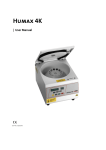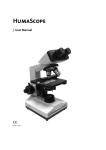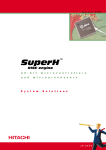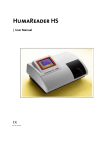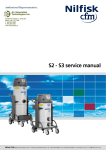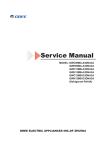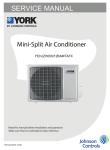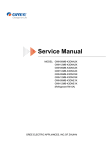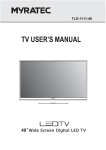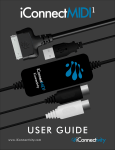Download - Frank`s Hospital Workshop
Transcript
Gtl`Qd`cdqGR | Service Manual | Cat.-No. 16670/2 QduhrhnmKhrsnesgdL`mt`k No. 1 2 i DATE / Rev. 01/2007-03 02/2007-05 REVISION DESCRIPTION First edition Correction of typing errors ii NOTICE Analytical instruments for in vitro diagnostic application involve the handling of human samples and controls which should be considered at least potentially infectious. Therefore every part and accessory of the respective instrument which may have come into contact with such samples must equally be considered as potentially infectious. BIOHAZARD The „BIOHAZARD“ warning label must be affixed to instrument prior to first use with biological material ! Servicing Note: Before doing any servicing on the instrument it is very important to thoroughly disinfect all possibly contaminated parts. Before the instrument is removed from the laboratory for disposal or servicing, it must be decontaminated. Decontamination should be performed by authorised well-trained personnel only, observing all necessary safety precautions. Instruments to be returned have to be accompanied by a decontamination certificate completed by the responsible laboratory manager. If a decontamination certificate is not supplied, the returning laboratory will be responsible for charges resulting from non-acceptance of the instrument by the servicing centre, or from authority’s interventions. HUMAN Gesellschaft für Biochemica und Diagnostica mbH | Max-Planck-Ring 21 · 65205 Wiesbaden · Germany | Tel.: +49 61 22/99 88-0 · Fax: +49 61 22/99 88-100 | e-Mail: [email protected] · www.human.de a b Bnmsdmsr 1 Instrument Specifications 2 2 Installation and daily maintenance 3 2.1 Unpacking the instrument 3 2.2 Environmental requirements 3 2.3 Connecting the printer and powering on the instrument 3 Function Description 4 3.1 Function description of power supply board 4 3.2 Function description of mainboard 4 3.3 Description of the principle of the mainboard 4 3.4 Function description of front-end board 4 3.5 Function description of control board 4 3.6 Function description of LCD transfer board 5 3.7 Function description of LCD screen 5 Daily Maintenance and Cleaning 6 4.1 Instrument cleaning 6 4.2 Maintenance of LCD touch-screen 6 4.3 Clean the fiber ends 6 Instrument Assembly/Disassembly & Replacement of Parts 7 5.1 Instruction on the disassembly instrument 7 3 4 5 5.2 Replacement of commonly used parts 5.2.1 Replacement of bulb 5.2.2 Replacement of light-filtering sheet 5.2.3 Replacement of front-end board 5.2.4 Replacement of photocell 5.2.5 Replacement of small cart 5.2.6 Replacement of drive board 5.2.7 Replacement of LCD transfer board 5.2.8 Replacement of optical fiber 5.2.9 Replacement of power supply unit 5.2.10 Filter installation 5.2.11 Filter Test 5.2.12 Check the AD value 7 7 7 8 8 8 9 9 10 11 11 13 13 6 Common Malfunctions & Solution 14 7 Component pictures 17 1 Instrument Specifications Weight: 10kg Overall dimensions: 450mm (L) x 330mm (W) × 140mm (H) Power: AC110V-AC250V 50-60Hz Fuses: 250V/3.15A Work Environment: temperature 10°C – 40°C; Humidity 20%-85% Store Environment: -20°C –50°C Lamp: OSRAM 64607, 8V/50W Standard Wavelength: 405, 450, 492, 630nm (substitute filters from 340-700nm available) Abs range: 0-3.500A Measurement range: 0-2.000A Accuracy: 0-2.0A: ±1.0%or±0.007A Precision: 0-2.0A: ±0.5%or±0.005A Linearity: ±2.0% or ±0.007A Reading speed: Continuous mode <5s, step by step mode <15s Warm up time: 1 minute CPU: Embedded RISC cpu Store content: 200 test, 1000 patient information, 10000 test data Interface: RS-232C serial interface, parallel printer interface Display: 5.7“ LCD display (320×240 discernibility,256 gray scale) Input: Touch panel and pen, external mouse (special order) 2/19 2 Installation and daily maintenance 8QSDFNLQJWKHLQVWUXPHQW Unseal the the packing box and remove the material used for transport. Retain the packing box and packing material for future transport. 1. Take the instrument out of the box. 2. Remove the packing material and remove the instrument from the plastic packing bag. 3. Check the contents of the packing box for the following: HUMAREADER HS user manual service manual power cord, RS-232 serial cable touch pen spare bulb mouse spare fuse (QYLURQPHQWDOUHTXLUHPHQWV Select a location not exposed to direct sunlight. The HUMAREADER HS should be placed on a smooth surface with sufficient working space. The front edge of the instrument should be close to the edge of the table. Avoid excessive vibrations (e.g. from a centrifuge). Note: the ambient working temperature should be between 10°-40°C, with humidity between 20%-85%. In order to ensure the proper functioning of the instrument, the following environmental conditions must be avoided: - large temperature fluctuations temperatures outside the recommended range dust proximity to equipment that generates an electromagnetic field The mains supply must fulfill the following requirements: Note: - AC90V-AC250V 50-60Hz 120VA - The AC mains supply must be well earthed Grasp the plug itself, not at the power cord, to unplug the power cord. &RQQHFWLQJWKHSULQWHUDQGSRZHULQJRQWKHLQVWUXPHQW 1) 2) 3) 4) 5) 6) 7) Make sure that both the printer and the instrument are switched off. Plug one end of the power cord into the instruments power socket. Plug the other end of the power cord into the AC socket. Plug one end of the parallel printer cable into the parallel port on the back of the printer. Lock the plug with the steel wire fastener Plug the other end of the printer cable into the instrument’s parallel printer port. Plug the printer’s power cord into the to AC mains socket. 3/19 +XPD5HDGHU+6Service Manual 3 Function Description )XQFWLRQGHVFULSWLRQRISRZHUVXSSO\ERDUG See 1. The electric power is provided by the switch power supply module, which outputs 6 channels of AC electric power. JP1 outputs 5V, used for the Mainboard board JP2 outputs 15V and –15V, used for the front-end board JP3 outputs 12V, used for the fan JP4 outputs 5V and 12V, used for the drive board to drive the light chopper’s motor and the lightfiltering wheel’s motor JP5 outputs 8V, used for the bulb JP6 outputs 5V, used for the LCD transfer board )XQFWLRQGHVFULSWLRQRIPDLQERDUG See 2. It acts as the system platform, providing the running environment for system software and application software; It provides the interfce that connects the front-end system, and conducts the control on the front-end system and data acquisition processing; It provides the I/O interfaces for the system. It supports one external RS232 interface and one parallel printer interface. 'HVFULSWLRQRIWKHSULQFLSOHRIWKHPDLQERDUG The mainboard board is composed of the following parts: SH7709, Flash Memory and DRAM compose the basic platform for the running of the system; system software and application software are written in Flash Memory. The system’s storage region 0 is assigned for Flash Memory’s address space; the low 32M space of the system’s storage region 3 is assigned for DRAM’s address space. CPU’s external frequency is 20MHz. When the system is booting, the program is executed directly on the Flash Memory. The startup region program on the Flash Memory is capable of updating the software. HD64461 and Frame Memory compose the system’s peripheral controller, which is mainly used to support LCD’s displaying; the high 32M space of the system’s storage region 3 is assigned for Frame Memory’s address space, which is directly connected with HD64461. HD64461 supports the interface with SH7709 and supports color/black-and-white STN-LCD interface. In the system, HD64461’s displaying interface is connected with LCD. There is one serial communication port and one parallel port on the mainboard: The serial port on SH7709 constitutes the RS232 port for external use; HD64461 and TL16C552 extended chip provide a parallel port for the system, and the extended parallel port is used to connect the external parallel printer. )XQFWLRQGHVFULSWLRQRIIURQWHQGERDUG See 3. It converts the instructions that come from the mainboard into driving signals and locating signals, so as to control the light-filtering wheel’s motor and control the predetermined-position attainment signal and reset signal for the small cart. It is also in charge of converting the lighting strength signal that the photocell received into digital signal and returning it to the mainboard. )XQFWLRQGHVFULSWLRQRIFRQWUROERDUG See 4. 4/19 The control board is in charge of receiving the control signals of the front-end board, providing voltage for lightchopper’s motor and driving the light-filtering wheel’s motor and belt wheel’s motor. )XQFWLRQGHVFULSWLRQRI/&'WUDQVIHUERDUG See 5. It is in charge of LCD screen’s displaying. It produces high voltage used for LCD screen, receives the touch signal that returns from the LCD screen and returns it to the mainboard. )XQFWLRQGHVFULSWLRQRI/&'VFUHHQ See 6. It displays and accepts the instructions generated by external touches. 6. 5. 2. 1. 3. 4. 5/19 +XPD5HDGHU+6Service Manual 4 Daily Maintenance and Cleaning ,QVWUXPHQWFOHDQLQJ - Keep the instrument’s working environment clean. Use neutral detergent and wet cloth to clean the surface of the instrument. Please clean the LCD with soft cloth. Clean the moveable working table with neutral detergent and wet cloth. Note: pleae keep this instrument away from any organic solvent, grease or corrosive substance. 0DLQWHQDQFHRI/&'WRXFKVFUHHQ - Please use the machine’s attached special-purpose pen for operation. Never touch the screen surface with sharp-pointed or high-hardness objects (such as metal, glass and etc), so as not to cause damage. If there is a great deviation of the position the arrow points at from the position you point at, the touchscreen need recalibration. &OHDQWKHILEHUHQGV Fiber ends Use the lens paper ( or special soft cloth) to clean them gently. 6/19 5 Instrument Assembly/Disassembly & Replacement of Parts ,QVWUXFWLRQRQWKHGLVDVVHPEO\LQVWUXPHQW Steps of disassembly: Fix the cover board of the microplate reader with adhesive paper. Switch off the instrument and the printer and disconnect the power cord. Remove the printer cable with a screwdriver. Spread a piece of soft silk cloth on a clean and smooth table-board. Turn the instrument upside-down and put it on the silk cloth, so as not to injure the external surface of the instrument’s plastic top cover. Remove the screws used to fix the top cover with a cross screwdriver. With the obverse side of the instrument facing upward, lift the top cover and expose the inside of the machine, as shown in the diagram above. Remove the corresponding part according to need. 5HSODFHPHQWRIFRPPRQO\XVHGSDUWV Note: you must observe carefully the positions and wiring of the original parts before replacing them, so as to restore the instrument. 5.2.1 Replacement of bulb - 5.2.2 Loosen a screw in the middle of the front-end of the machine and lift the top cover of the machine. Loosen the screws of the two black light-masking boards on the right of the machine and remove the two light-masking boards. Loosen the fastening screw of the bulb and disconnect the power cord of the bulb. Replace it with a new bulb and restore the instrument. Replacement of light-filtering sheet - Similar to the replacement of bulb, open the top cover of the machine and remove the light-masking board. - Remove the two internal hexagonal screws (the upper one and the lower one) used to fasten the light-filtering wheel’s motor. - Loosen the 3 fastening screws on the light-filtering wheel. - Pull the motor outward gently by 2-3 cm and take out the light-filtering wheel. Replace the lightfiltering sheet and restore the instrument. Note: not to scrape the surface of the light-filtering sheet when replacing it. internal hexagonal screw fastening screw 7/19 +XPD5HDGHU+6Service Manual 5.2.3 Replacement of front-end board - 5.2.4 Replacement of photocell - 5.2.5 Open the top cover of the machine and remove the light-masking board. Disconnect the power cord and signal cord of the front-end board and remove the fastening screw. Please note where the power cord and the small signal cord, which come from beneath the board, are connected before removing the old front-end board. Wedge the new front-end board in its proper position and connect the power cord and the small signal cord properly. Fix the screw in place. Note that the Hall module at the bottom right corner shall not stick up. Open the top cover of the machine and remove the light-masking board. Remove the front-end board and the photocell’s fastening screw on the front-end board. Remove the old photocell by soldering and replace it with a new one. Fix the fastening screw in place and restore the front-end board. Replacement of small cart - Open the top cover of the machine and remove the light-masking board. Remove the two fastening screws under the fastening frame of the cart slideway on the right of the small cart. Remove the fastening frame of the slideway and remove the slideway. - Loosen the belt’s fastening screw at the top left corner of the small cart and turn the small cart by 180 degrees. - Remove the small cart’s fastening screw and replace the small cart with a new one. - Fix the screw in place and turn the small cart by 180 degrees to restore it. - Tighten the fastening screw to ajust the belt to a proper elasticity. - Restore the slideway and the fastening frame. the position of the belt’s fastening screw slideway Fastening frame 8/19 5.2.6 Replacement of drive board - Open the top cover of the machine and remove the light-masking board. - Remove the internal hexagonal screw used to fasten the working table and loosen the 3 screws used to fasten the optical fiber. - Lift the working table with care and disconnect the wiring on the drive board. - Remove the screws and replace the drive board with a new one. - Restore the machine. Note: To protect the optical fiber during replacement; protect against static electricity. Not to confuse light-filtering plate motor cable with the 5pin power supply unit cable. Not to omit the insulative pad in installation. 5.2.7 Replacement of LCD transfer board - Open the machine cover and remove the light-masking board. Disconnect the wiring on the transfer board and loosen the fastening screw. Replace it with a new board and restore the instrument. LCD transfer board 9/19 +XPD5HDGHU+6Service Manual 5.2.8 Replacement of optical fiber - Open the machine cover and remove the light-masking board. Remove the 3 screws used to fasten the optical fiber head and push the optical fiber head out. Remove the 4 internal hexagonal fastening screws on the front, left and right of the working table and remove the 2 screws used to fasten the optical fiber bracket. Lift the working table with care and remove the optical fiber and the optical fiber bracket. Then remove the two screws on the optical fiber bracket and remove the optical fiber. Replace the optical fiber with a new one and install it on the optical fiber bracket. - Fix the optical fiber bracket on the working table and reinstall the optical fiber head and the working table with care. The fastening screw for the optical fibre head 10/19 The fastening screw for the optical fiber bracket 5.2.9 Replacement of power supply unit - Disassemble the machine and remove the light-masking board. Remove the working table and disconnect all the wiring of the power supply unit. Remove the fastening screws of the power supply unit and then remove the power supply unit’s locating screw at the bottom of the machine. Replace the power supply unit with a new one and restore the machine. Power supply unit 5.2.10 Filter installation 1. 2. 3. 4. Turn off the instrument. Remove the only one screw and open the cover of the Reader. Remove the four screws and take off big black cover, which cover the lamp, filter wheel, motor etc. Use a small cross screwdriver to loosen the three screws, which fix the filter wheel. 11/19 +XPD5HDGHU+6Service Manual Special screws fix the motor Screws fix the filter wheel Filterwheel 5. Use a special screwer to remove the motor which fix the filter wheel motor. 6. Plug out the filter wheel motor and take out the filter wheel including filters. 7. Use a forceps to install filter (e.g.520nm) in #4. From #0 to 3 are the fixed filters, it should be moved. See figure below. 7 Gap 6 0 1 5 2 3 Note: Don’t touch the filters with your finger. 8. Finish the install of filters, then install filter wheel with motor correctly. Remember to screw the three screws to fix the filter wheel. 9. Install the black cover, connect the power cable and turn on the instrument. 10. On the main screen click top right corner several times. 12/19 11. Enter the Manufacture setting window, which is not available for common user. 12. Click the User param, enter Filter and Abs modify modulus window. The #0-405, #1-450, #2-492 and #3630 are the fixed filters orderly, you should not change them. 13. If you have installed the filter ( e.g. 520nm ) at #4, you should set #4-520. Double click #4-N/A to input 520 in the window “Input filter wavelength (300-800)“, then click OK. Remember: Don’t modify k value and b value in the next two windows. The K=1.000, b=0.000, if the value have been change, please click reset to reset the value. 14. Exit to the Manufacture setting window. 5.2.11 Filter Test 1. Enter the Manufacture setting window. 2. Click “Front debug“ enter another window, at the plate testr line, select “continue, the relative filter (490nm) as main wavelength, “none“ for second wavelength. 3. At the lamp voltage line, select “1“ then clicks “Lamp voltage“ to turn in the lamp. You can see the lamp is lighted from the fan’s windows. 4. Click “Air blank“ then click “Plate test“, the plate carrier will move in and out for one time. 5. Click AD enter the test result window, all the results ( AD value ) listed should be between 6000 and 60000 (new lamp and new filter: 16000—60000) 6. Exit, click ABS to see the ABS results, all the results should not be more than r0.001A. 7. Exit to the main screen, and then turn off the instrument normally. 8. Turn on the instrument 2 minutes later, now you can work with the new filters. 5.2.12 Check the AD value 1. 2. 3. 4. 5. 6. 7. 8. On the main screen click top right corner several times. Enter the Manufacture setting window, which is not available for common user.. Click the Front debug button At the “plate test“ line, select “continue“, the relative filter ( 450nm ) as main wavelength, “none“ for second wavelength. At the “Lamp voltage“ line, select “1“ then clicks “Lamp voltage“ to turn on the lamp. You can see the lamp is lighted from the fan’s window.( See figure 3 ) Click “Air blank“ then click “Plate test“, the plate carrier will move in and out for one time. Click AD enter the est result window, all the results ( AD value ) listed should be between 6000 and 60000 ( new lamp and new filter: 16000—60000 ) Exit, click ABS to see the ABS results, all the results should not be more than r0.001A. Note: during the test, there should no load any plate on plate holder 13/19 +XPD5HDGHU+6Service Manual 6 Common Malfunctions & Solution Malfunction Solution The small cart can not move The supporting frame in the middle of the small cart is not properly smoothly on the board and rubs installed. against the optical grating board. Reinstall the supporting frame. Report “492 wavelength is too The bulb is aging. weak” when start the machine. - Replace the bulb. The light-filtering sheet is broken. - Replace the light-filtering sheet and ajust the frequency and synchronization of the light-chopper wheel. Report “shared ROM error” when Too short separation between the starts of the machine. start the machine. - It shall be above 3 minutes. No ground wire or the ground wire is in poor contact. ---Earthing the instrument properly. The machine is started in the wrong order. - You should switch on the host computer first and then the printer. The front-end board error. - Add a 4.7K resistor to between the 10th pin and the 18th pin of U11 on the front-end board. Report “405 light strength is too The bulb fell off or is not properly installed. weak” when start the machine. - Reinstall the bulb. The light-filtering sheet is broken. - Replace the light-filtering sheet. The bulb is aging. - Replace the bulb. The optical fiber is damaged. - Replace the optical fiber. The photoelectric reaction board on the front-end board is broken. - Replace the photoelectric reaction board. The clock is out of order and need The battery is electrically discharged. to be re-set up every time the - Replace the battery. machine is started. No display on the screen when The flat data cable that connects the displaying screen to the transfer board start the machine. is loose or fell off. - Re-plug it. The ground wire of the transfer board fell off or is in poor contact. - Reconnect it. The transfer board is broken or fell off. - Replace it or solder it. The displaying screen is broken. - Replace the displaying screen. The mainboard is broken. - Replace the mainboard. 14/19 Report “shared ROM (RAM) error” No ground wire or the ground wire is in poor contact. when start the machine, and then - Earthing the instrument properly. all the data stored in the machine The machine is started in the wrong order. are lost. - You should switch on the host computer first and then the printer. The front-end board error. - Add a 4.7K resistor to between the 10th pin and the 18th pin of U11 on the front-end board. The front-end board is broken. - Replace the front-end board. The touch screen is inaccurately Re-locate the touch-screen. located. The touch-screen is broken. - Replace the touch-screen. The Q1-Q6 triode on the mainboard is broken. - Replace the Q1-Q6 triode. The screen suddenly becomes a The voltage is not stable. blank screen, and after a while, it - Connect it with a manostat. restore normal displaying. The flat data cable that connects the displaying screen to the transfer board is loose. - Re-plug it. The clip hood of the small cart is Replace the small cart. damaged. The belt is broken. Replace the belt. The printer can not print. The model of the printer is improperly set up. - Re-set up the model of the printer. The printing cable fell off. - Re-plug the printing cable. The printer is broken. - Replace the printer. Report “no predetermined-posi- Too long distance between the Hall module at the bottom right corner of tion attainment signal for the the front-end board and the magnetic ball of the small cart. enzyme label plate” when start - Adjust the position of the Hall module. the machine. The photoelectric coupler. - Replace the photoelectric coupler. The front-end board is broken. - Replace the front-end board. Report “no reset signal for the The position of the driving motor is deviated. plate” when start the machine. - Reajust it and fix it. The optical grating bar fell off. - Glue the optical grating bar. The drive board is broken. - Replace the drive board. 15/19 +XPD5HDGHU+6Service Manual Data can not be transferred to the The serial port cord is broken. computer. - Replace the serial port cord (the normal serial port twisted-wire shall be 23, 3-2 and 5-5). Data transference shall be conducted in the main menu of the software. - External software error. Reinstall the software. Logarithmic regression curve is in confusion. testing The precence of a 0 concentration standard in logarithmic regression does not allow the calculation. - Remove the 0 concentration standard or change the concentration. I.e 0.01. The testing results are on the high Recommend the use of double-wavelength method of testing. side. Select 630 as the secondary wavelength. Report “FLASH self-check error” The FlashROM on the mainboard is broken. when start the machine. - Replace it. No display when printing the syn- System software error. thetic report for the testing item. - Update the system software. Report “the front-end command is The power supply board’s 5V voltage is on the low side. overtime” in the self-check when - Replace the V18 on the power supply board. start the machine. Fail to start the machine. The bulb Irregular power supply. is flashing. - Replace the power supply unit Report “please check the light- The circuit between the 1st pin of U8 on the front-end board and the drive chopper’s motor” in the self-check board is broken. when start the machine. - Reconnect it. 16/19 7 Component pictures Lamp Cat. No. 16670/10 Plate holder Cat. No. 16670/27 Touch pen Cat. No. 16670/40 Front board & photocell Cat. No. 16670/17 17/19 +XPD5HDGHU+6Service Manual Transfer board Cat. No. 16670/21 Driving board Cat. No. 16670/22 Mainboard Cat. No. 16670/16 Power supply assembly Cat. No. 16670/31 18/19 Filter wheel Filter Ring Cat. No. 16670/15 19/19 +XPD5HDGHU+6Service Manual HUMAN Gesellschaft für Biochemica und Diagnostica mbH | Max-Planck-Ring 21 · 65205 Wiesbaden · Germany | Tel.: +49 61 22/99 88-0 · Fax: +49 61 22/99 88-100 | e-Mail: [email protected] · www.human.de 02/2007-05


























